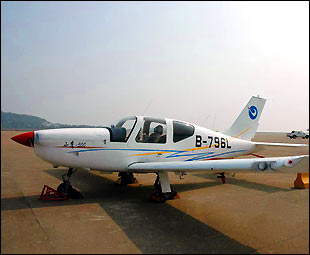http://www.my-india.net/forum1/messages/583.shtml
Shortage of Pilots in Indian Aviation Secotor
For several decades Indian Civil Aviation has suffered from flawed regulatory and operational policies that were designed solely  to keep competition away, The Govt did adopt an 'open sky' policy in 1991 but this proved to be relatively ineffective because the civil aviation environment then was not conducive for sustaining a high-quality competitive level. As a result, many startup airlines exited the industry within a short time, However, far-reaching reforms in the civil aviation sector aimed at making flying more affordable gathered momentum as 2004 came to a close, As the new Govt completed a year in office, a major change witnessed in this sector was the entry of Low-Cost Carriers (LCC), a feature unseen in the Indian aviation scene so far.
As a result, India's civil aviation has witnessed an unprecedented boom. Finally in 2005 the aviation sector was freed of bureaucratic  shackles and stifling Govt restrictions, the industry is now poised to expand by leaps and bounds. The recent Govt announcements regarding the much-awaited fleet acquisition programme of Indian public sector airlines as well as for modernisation of the infrastructure at Indian airports have given the process a further fillip.
At present, existing private domestic carriers as well as the new startups have a total of 337 aircraft on order, mostly Boeing and Airbus variants and some ATR and Embraer aircraft. Of these, as many as 156 were ordered at the Paris air show in June. IndiGo leads the list with a firm order for 100 A320s with deliveries slated for late 2006; between 15 and 19 aircraft in the first two years, and thereafter an average of one aircraft every month. Air Deccan is close behind with orders for 68 additional aircraft comprising 32 ATR 72/42s and 32 A320s. Kingfisher Airlines became the first Indian carrier to sign a firm contract with Airbus for five each of its newest aircraft, the A350-800 and its larg
, the A380 for intercontinental services as well as for five A330-200s for regional routes. Â Delivery of the A330s is due to begin in the third quarter of 2007, those of the double-deck A380s in 2010 whilst the A350s will arrive in 2012. A host of other new domestic carriers have also placed substantial orders with various manufacturers with most deliveries slated for late 2005 and spilling over into 2006.
At present, existing private domestic carriers as well as the new startups have a total of 337 aircraft on order, mostly Boeing and Airbus variants and some ATR and Embraer aircraft.
Not to be left behind, the national carriers have also planned substantial acquisitions. Air India has finalised a revised fleet plan through which its fleet size would be enhanced from the present level of 34 aircraft to 74 aircraft by the year 2012-13. This entails purchase of 50 aircraft from Boeing (8 Boeing 777-200LR, 15 Boeing 777-300ER and 27 Boeing 787s) at a projected cost of Rs 30000 crore (US$ 7 billion). Acquisition of 43 aircraft (19 Airbus A319, 4 Airbus A320 and 20 Airbus A321) along with related spares, spare engines, equipment, etc has since been approved for Indian Airlines at a total cost of Rs 9700 crore (US$2.2 billion).
It is anyone’s guess as to Human Resource requirements, especially pilots , airhostesses, flight attendants and other cabin crew, that are going to come up in the Aviation Sector. Demand is much above the number of people acquiring training for the same. Jet Airways along with Sahara India has about 47 percent share of the domestic aviation market, followed by Indian Airlines (28 per cent), Air Deccan (11 per cent), Kingfisher (6 per cent) and SpiceJet (5 per cent) as on October2006.
Jet Airways tops the list of domestic and national carrier operators with 8,168 flights operating till June 2005. Indian Airlines ranks second with 7,562 flights, followed by Sahara (3,225 flights), Air Deccan (2,889 flights), Spice Jet (483 flights) and Kingf
er Airlines (267 flights).
The sudden boom in Indian aviation has caught even the normally market savvy global aerospace manufacturers unawares. Recently, both Boeing and Airbus said they had underestimated Indian growth. This means global players are also coming into the scene. Â Â Â Â
It wasn't surprising since statistics compiled by Airbus Industrie showed that Indian carriers accounted for 327 out of the 2,140 firm orders for new aircraft that were placed with it and rival Boeing in 2005. This does not take into account the orders placed for smaller airplanes with other manufacturers like ATR and Dassault - which, too, are flooded with offers from private Indian carriers.
The Brazilian aircraft manufacturer, Embraer, is bullish on the prospects in the Indian market. Their forecast is that between 2006 and 2010, the demand for 30-120-seater planes in India would be around 165, which is about 40 per cent of the demand of the Asia-Pacific region. The value of these aircraft would be around $4 billion. They feel that a majority of the aircraft required will be in the 61-120-seat capacity segment. 70 per cent of these would be required for market growth while there would be a small demand for replacement.
Indian Domestic Carriers have started attracting Foreign Pilots with lucrative offers. With the boom in Indian service sector and tourism industry, the impetus given by them to the aviation industry has made most domestic airlines in India with severe shortage of trained pilots, as they had to increase the sectors of their flights manifold overnight. This has changed the whole aviation job scenario in India. There are applications from pilots from across the world, primarily US, Europe and Australia and the pay packages are much more competitive now.



